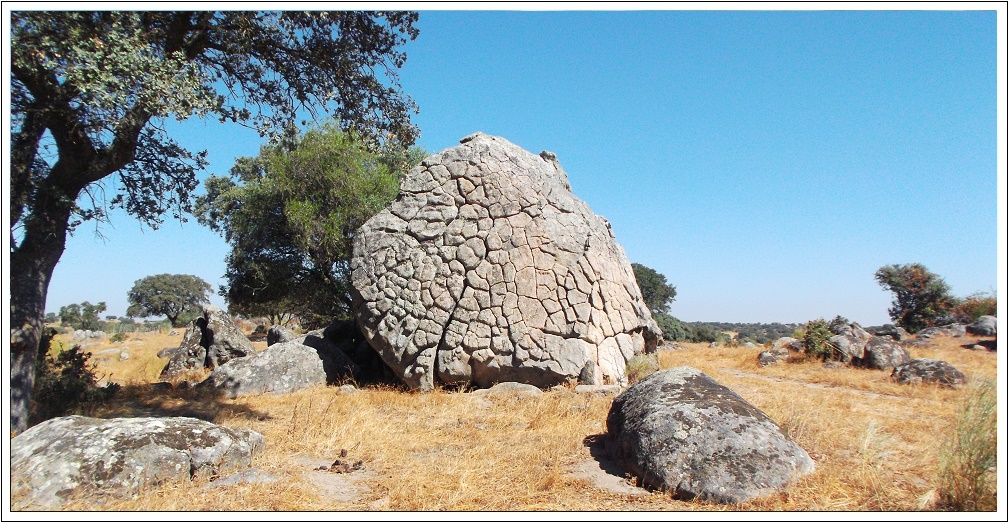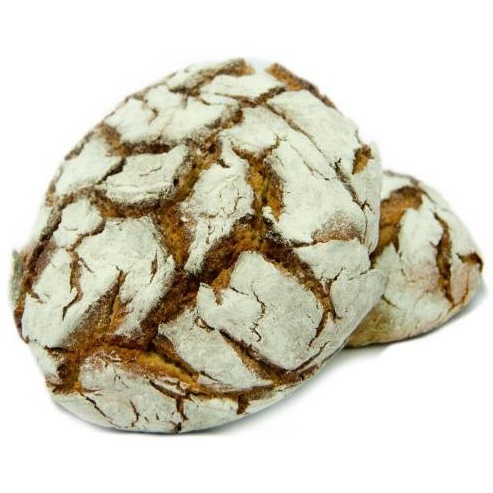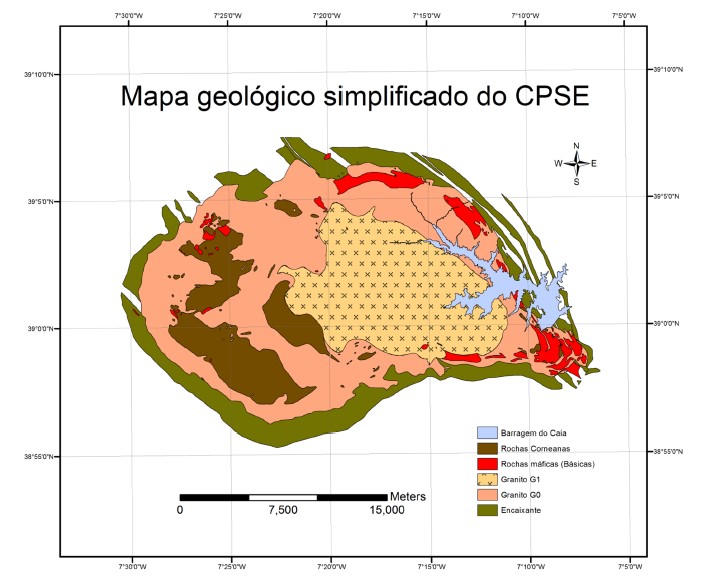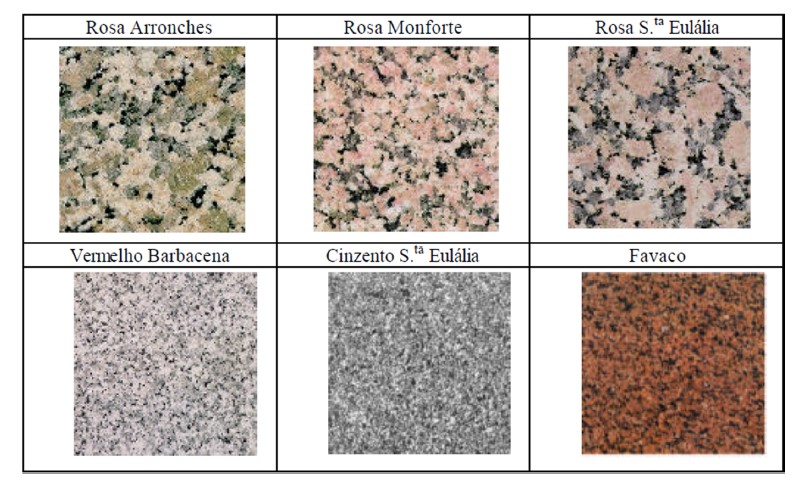


A "Broa" do Caia
Esta EarthCache está localizada no Complexo Plutónico de Santa Eulália, onde existe um afloramento rochoso granítico calco-alcalino. Este complexo apresenta grande interesse para a exploração de rochas ornamentais e já tem vindo a ser explorado para este fim há diversos anos.

Imagem 1 – Mapa Complexo Plutónico de Santa Eulália (imagem retirada de: https://repositorio-aberto.up.pt/bitstream/10216/69917/2/11865.pdf)

Rochas plutónicas – o granito
O granito é uma rocha plutónica ou intrusiva uma vez que resulta do arrefecimento e solidificação do magma em zonas profundas da crusta terrestre.
O granito pode apresentar diferentes cores como cinzento, amarelado, acastanhado, azulado, avermelhado, por vezes esverdeado.

Imagem 2 - Exemplos de rochas exploradas no Complexo Plutónico de Santa Eulália. (imagem retirada de: https://repositorio-aberto.up.pt/bitstream/10216/69917/2/11865.pdf)
Os principais minerais do granito são feldspatos (ortoclase e plagioclase), quartzo, e em menor quantidade a biotite, a augite, a horneblenda, a moscovite, a apatite, o zircão e a magnetite. As diferentes cores encontradas devem-se aos feldspatos.
A textura (aspeto geral da rocha resultante das dimensões, forma e arranjo dos minerais) do granito é considerada fanerítica uma vez os minerais são bem visíveis a olho nu e a cristalização é completa devido ao arrefecimento lento do magma que lhe deu origem.
A "Broa" do Caia
No exato local onde se encontra o GZ pode ser visto um bloco rochoso que carinhosamente apelidamos de "Broa" do Caia.
Esta “Broa” do Caia terá surgido pela meteorização (alteração física e química da rocha) e erosão (remoção dos sedimentos que se formaram pela meteorização) diferencial do granito.
Conforme o que já foi explicado anteriormente, o granito é uma rocha magmática plutónica ou intrusiva (isto significa que o magma que lhe dá origem arrefece e solidifica no interior da crusta terrestre) e que apenas surge à superfície por desgaste do material que se encontra por cima e/ ou através de movimentos das placas tectónicas. Isto significa que ao aflorar à superfície as condições a que os minerais que o constituem irão estar sujeitos serão bem distintas daquelas em que se formaram tendo inicio a sua meteorização.
Provavelmente nesta localização, as grandes amplitudes térmicas terão tido um importante papel na meteorização do granito que se encontra nas coordenadas.
Devido então ao tipo de meteorização ocorrida no granito, a erosão terá sido diferencial, uma vez que os agentes erosivos (gravidade terrestre, vento, água…) terão removido os materiais mais alterados ficando o bloco de granito como o típico aspeto de uma broa. Por razões óbvias, os geólogos arranjaram um nome mais pomposo: fissuração poligonal.

Como logar esta earthcache:
Para logar esta earthcache terá de se deslocar ao local e responder às seguintes quatro questões:
a) Dos diferentes tipos de granito que se encontram representados na imagem 2, qual é o que mais se assemelha ao granito que constitui a "Broa"?
b) Qual é a altura aproximada do bloco?
c) Qual é a largura aproximada da fissura de maior dimensão?
d) Qual é a orientação da face que apresenta a fissuração poligonal na "Broa" do Caia (ou seja a "côdea")?
e) Para além disto terão de fazer, obrigatoriamente, upload de uma foto vossa ou do vosso nick nas coordenadas. (novas regras desde 12 de junho de 2019)
Envie as respostas através do nosso perfil de geocaching e desfrute da sua visita. Nós rapidamente daremos feedback a autorizar (ou não) o log.
Logs contendo as respostas ou fotografias reveladoras das respostas serão imediatamente eliminados!


Caia's "Cornbread"
This EarthCache is located in the Plutonic Complex of Santa Eulalia, where there is a rocky outcrop of calc-alkaline granite. This complex is of great interest for the exploitation of ornamental rock and already has been explored for this purpose for some years.

Picture 1 - Map of the Plutonic Complex of Santa Eulália (picture taken from: https://repositorio-aberto.up.pt/bitstream/10216/69917/2/11865.pdf)

Plutonic rocks - granite
Granite is a plutonic or intrusive rock that results from the cooling and solidification of magma in deep areas of the Earth's crust.
Granite can have different colors such as gray, yellowish, brownish, bluish, reddish and even sometimes greenish.

Picture 2 - Examples of rocks explored in the Plutonic Complex of Santa Eulália. (image taken from: https://repositorio-aberto.up.pt/bitstream/10216/69917/2/11865.pdf)
The principal minerals of granite are feldspar (plagioclase and orthoclase), quartz, and in less amount we can find biotite, augite, the hornblende, muscovite, apatite, zircon and magnetite. The different colors of the granite are due to feldspar.
The texture (general aspect of rock due to size, shape and arrangement of minerals) granite is considered phaneritic because the minerals are visible to the naked eye and crystallization is complete due to the slow cooling of magma.
Caia's "Broa"
In the exact spot where the GZ is it can be seen a rocky block that we affectionately nicknamed Caia's "Broa" (broa means "corn bread" in portuguese).
The "Broa" of Caia was formed by weathering (physical change and chemical of the rock) and differential erosion (erosion is the removal of sediment that was formed by weathering) of the granite.
As it was explained earlier, granite is an plutonic or intrusive rock (this means that the magma cools and solidifies within the Earth's crust) and only comes to the surface when the material that lies above is eroded and / or by movements of the tectonic plates.
This means that the rock that surfaces will be in very different conditions and the weathering will begin.
Probably in this location, the large temperature variations had played an important role in the weathering of granite that is in the coordinates.
Due to the type of weathering occurred in granite, the erosion is differential, since the erosive agents (terrestrial gravity, wind, water,...) remove the most altered material leaving the block of granite with as the typical appearance of corn bread. For obvious reasons, geologists arranged a more pompous name: polygonal cracking.

How to log this EarthCache:
To log this EarthCache you will have to go to the location and answer the following four questions:
a) Looking at the different types of granite that are represented in figure 2, which is the one that most resembles the granite of the "Broa"?
b) What is the approximate height of the block?
c) What is the approximate width of the larger fissure?
d) What is the orientation of the face that shows the polygonal cracks in the Caia's "Broa" (namely, the "crust")?
e) Beside that you really need to upload a photo of you or your nickname at the published coordinates. (new guidelines after June 12th of 2019)
Send us the answers via our geocaching profile and enjoy your visit. We will quickly give you feedback authorizing (or not) the log.
Logs containing the answers or revealing photographs of the answers will be immediately removed!
Boa cachada!
 VillEcoueR
VillEcoueR

